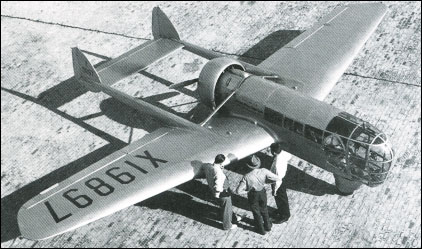|
| There is no text information for this aircraft at the moment.
| Test, e-mail, 22.06.2024 19:40 Test 1 reply |
| Barry, 30.06.2016 14:46 For all of us who have limited French i.e. me let me give you the spec. included in the post from Francis Maigne in December 2009.
Power plant 1 x 365 h.p. Wright R-975E-1 9 cylinder radial
Crew 1 pilot plus 1 passenger
Span 36'8" Length 26'6" Height 6'4" Wing area 200 sq ft
Empty weight 2,100 lb Max take off weight 3,400 lb
Max speed at 10,000 ft 200 mph Cruising speed at 10,000 ft 175 mph
Range 1,400 miles Service ceiling 20,000 ft reply | | John Parrish, e-mail, 07.06.2012 16:45 I attended the Lansing Community College Aviation Maintenance Program in the late 70's. We had Mr. Abram's (Explorer) in our hangar. It was a teaching tool. Great airplane and the airport in Grand Ledge Michigan is "Abram's field". reply | | Klaatu, e-mail, 25.04.2011 19:05 This fascinating airplane was specially designed for photographic aerial survey work, and was apparently quite successful in that role. It's creator was an expert in aerial photography, and the plane was specifically designed with that purpose in mind. Only one was built and it still exists. It is under restoration at the Udvar Hazy facility of the Smithsonian Institute. reply | |
| | Willis Vanderberg, e-mail, 29.11.2010 00:50 I saw this aircraft many times. It was sitting in the hanger at Brooks Field, Marshall Michigan. This was during WWll. My father was in the Civil Air Patrol and they flew out of that airfield. reply | | Dick Freeman, e-mail, 24.10.2010 23:04 I knew Ted Abrams when the two of us were at Curtiss-Wright. He was a fine engineer and had a great love for
photography. Later I worked on the 'TERCOM' system of
terrain matching for missile guidance. reply | | Mark Calder, e-mail, 08.09.2010 16:09 Ted Abrams commissioned this design. I met Mr. Abrams before he died in the late 70's. I was a student technician at Abrams planetarium on the campus of Michigan State University. Mr. Abrams told me that the explorer was designed for high longitudinal stability. The plane was used to fly parallel mapping courses that needed to be very precise. Mr. Abrams is considered the father of Stereo aerial photography. His process used a set of binocular viewers that could be used to trace contour lines. The company was eventually sold to Curtiss Wright, then later to McDonnell Douglas. The technology was later developed into digital terrain mapping that was used in early cruise missiles before GPS. The plane currently is in storage at Silver Hill at the Smithsonian's restoration facility.
That's not a ducted fan by the way, its a engine cowling called a Townsend ring. It was developed by NACA to reduce cooling drag around a radial engine. reply | | Francis Maigné, e-mail, 22.12.2009 20:05 Explorer
Monomoteur de travail photographique, multiplace en cabine fermée et abondamment vitrée, dont le nez pratiquement tout vitré, monoplan voilure médiane cantilever droite, bipoutre, celles-ci prenant naissance au bord de fuite de la voilure et portant l'empennage horizontal et les deux dérives, train tricycle fixe à roues carénées. Contruction entièrement métallique. 1 moteur propulsif de 9 cylindres en étoile Wright Whirlwind R.975-E-1 de 365 cv, hélice bipale métallique à pas variable, E: 11,20 m, L: 8, 10 m, H: 1,90 m, Sa: 18,60 m², Pv: 590 Kg, Ptc: 1542 Kg, C /a: 82,9 Kg /m², P /p: 4,224 Kg /cv, Vm: 322 Km /h à 3000 m, Pl: 6100 m, Auto: 1900 Km. 1937, 1 exemplaire. reply | | FIXED WING ADDICT, e-mail, 25.04.2009 14:19 Its not a ducted fan it does have an anular radiator the prop is much larger than the corl reply | | runningdog, e-mail, 29.01.2009 19:17 There's photo and film on 'youtube' and a simple 3-view on the Flightglobal /Archive site. reply | | John, 05.12.2008 20:32 yes, the nose dose look like that of the R-5. Anybody know of any 3 views of this aircraft? reply | | Bob, e-mail, 03.05.2008 17:49 The engine is a supercharged 450hp P&W. Aircraft was built in Marshall, Michigan by Ronan and Kunzul for Abrams. reply | | calum morris, e-mail, 15.03.2008 16:27 hey
in response to the comments made
you can c the prop clear as day without looking to the shadow, near the right boom.
also is it me or does the front look like that of the sikorsky R-5!!! reply | | Aero-Fox, 11.03.2008 04:56 This thing almost has swept wings...that's pretty advanced design for 1936...
I like the large glass area and pusher-prop arrangement too... reply |
|
| | Aerodog, e-mail, 08.01.2008 05:50 It's a "one-off" aircraft designed for survey work, mapping, etc. There's a nice photo in "The World's Worst Aircraft," but it reportedly flew well. The book simply suggests it was "ungainly." I think it would have been a blast to fly due to the view, and the 1930's streamlining makes it look like a flying diner. How cool is that!? reply | | liv, e-mail, 30.09.2007 21:31 Not sure it's a ducted fan , could be the engine cowling if the engine is a radial (you can see the prop in the shadow) reply | | Paul, e-mail, 19.07.2007 02:39 Anyone notice this is a ducted fan airplane? Anything new under the sun? No? reply |
|
Do you have any comments?
|
| |










TEST 333 333 333
reply